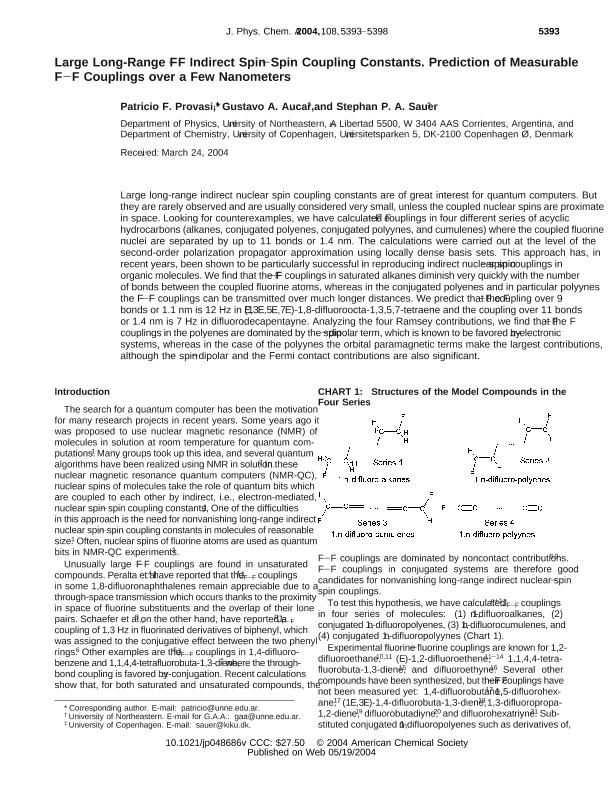Mostrar el registro sencillo del ítem
dc.contributor.author
Provasi, Patricio Federico

dc.contributor.author
Aucar, Gustavo Adolfo

dc.contributor.author
Sauer, Stephan P. A.

dc.date.available
2017-08-14T17:24:03Z
dc.date.issued
2004-05
dc.identifier.citation
Provasi, Patricio Federico; Aucar, Gustavo Adolfo; Sauer, Stephan P. A.; Large long-range F-F indirect spin-spin coupling constants. Prediction of measurable F-F couplings over a few nanometers; American Chemical Society; Journal of Physical Chemistry A; 108; 25; 5-2004; 5393-5398
dc.identifier.issn
1089-5639
dc.identifier.uri
http://hdl.handle.net/11336/22290
dc.description.abstract
Large long-range indirect nuclear spin coupling constants are of great interest for quantum computers. But they are rarely observed and are usually considered very small, unless the coupled nuclear spins are proximate in space. Looking for counterexamples, we have calculated F−F couplings in four different series of acyclic hydrocarbons (alkanes, conjugated polyenes, conjugated polyynes, and cumulenes) where the coupled fluorine nuclei are separated by up to 11 bonds or 1.4 nm. The calculations were carried out at the level of the second-order polarization propagator approximation using locally dense basis sets. This approach has, in recent years, been shown to be particularly successful in reproducing indirect nuclear spin−spin couplings in organic molecules. We find that the F−F couplings in saturated alkanes diminish very quickly with the number of bonds between the coupled fluorine atoms, whereas in the conjugated polyenes and in particular polyynes the F−F couplings can be transmitted over much longer distances. We predict that the F−F coupling over 9 bonds or 1.1 nm is 12 Hz in (1E,3E,5E,7E)-1,8-difluoroocta-1,3,5,7-tetraene and the coupling over 11 bonds or 1.4 nm is 7 Hz in difluorodecapentayne. Analyzing the four Ramsey contributions, we find that the F−F couplings in the polyenes are dominated by the spin−dipolar term, which is known to be favored by π-electronic systems, whereas in the case of the polyynes the orbital paramagnetic terms make the largest contributions, although the spin−dipolar and the Fermi contact contributions are also significant.
dc.format
application/pdf
dc.language.iso
eng
dc.publisher
American Chemical Society

dc.rights
info:eu-repo/semantics/openAccess
dc.rights.uri
https://creativecommons.org/licenses/by-nc-sa/2.5/ar/
dc.subject
Nmr
dc.subject
Spin-Spin Coupling Constant
dc.subject
Long Range Coupling Constant
dc.subject
Fluorine-Fluorine
dc.subject.classification
Otras Ciencias Físicas

dc.subject.classification
Ciencias Físicas

dc.subject.classification
CIENCIAS NATURALES Y EXACTAS

dc.title
Large long-range F-F indirect spin-spin coupling constants. Prediction of measurable F-F couplings over a few nanometers
dc.type
info:eu-repo/semantics/article
dc.type
info:ar-repo/semantics/artículo
dc.type
info:eu-repo/semantics/publishedVersion
dc.date.updated
2017-08-04T15:40:55Z
dc.identifier.eissn
1520-5215
dc.journal.volume
108
dc.journal.number
25
dc.journal.pagination
5393-5398
dc.journal.pais
Estados Unidos

dc.journal.ciudad
Washington D. C.
dc.description.fil
Fil: Provasi, Patricio Federico. Consejo Nacional de Investigaciones Científicas y Técnicas; Argentina. Universidad Nacional del Nordeste. Facultad de Ciencias Exactas y Naturales y Agrimensura. Departamento de Física; Argentina
dc.description.fil
Fil: Aucar, Gustavo Adolfo. Consejo Nacional de Investigaciones Científicas y Técnicas; Argentina. Universidad Nacional del Nordeste. Facultad de Ciencias Exactas y Naturales y Agrimensura. Departamento de Física; Argentina
dc.description.fil
Fil: Sauer, Stephan P. A.. Universidad de Copenhagen; Dinamarca
dc.journal.title
Journal of Physical Chemistry A

dc.relation.alternativeid
info:eu-repo/semantics/altIdentifier/url/http://pubs.acs.org/doi/abs/10.1021%2Fjp048686v
dc.relation.alternativeid
info:eu-repo/semantics/altIdentifier/doi/http://dx.doi.org/10.1021/jp048686v
Archivos asociados
